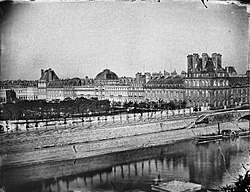
Back Tuileries-paleis Afrikaans قصر تويلري Arabic Tüilri sarayı Azerbaijani Цюільры (палац) Byelorussian Цюільры BE-X-OLD Тюйлери Bulgarian Palez an Tuileries Breton Palau de les Teuleries Catalan کۆشکی تویلێریس CKB Palais des Tuileries Czech
| Tuileries Palace | |
|---|---|
Palais des Tuileries | |
 The Tuileries Palace from the Solférino bridge, mid 19th century. The Pavillon de Flore at right | |
 | |
| General information | |
| Type | Royal and Imperial residence |
| Architectural style | Construction work started in the 16th century (Renaissance). Additions of the 17th and 18th centuries (Louis XIII style and Baroque). Additions of the 19th century (Neo-Classicism, Neo-Baroque and Second Empire style). |
| Coordinates | 48°51′44″N 2°19′57″E / 48.86222°N 2.33250°E |
| Construction started | 1564 |
| Completed | 1860s |
| Demolished | 30 September 1883 |
The Tuileries Palace (French: Palais des Tuileries, IPA: [palɛ de tɥilʁi]) was a royal and imperial palace in Paris which stood on the right bank of the Seine, directly in the west-front of the Louvre Palace. It was the Parisian residence of most French monarchs, from Henry IV to Napoleon III, until it was burned by the Paris Commune in 1871.
Construction began in 1564, originally to serve as a home for Queen Catherine de' Medici, and it was gradually extended until it closed off the western end of the Louvre courtyard and displayed an immense façade of 266 metres. Since the destruction of the Tuileries, the Louvre courtyard has remained open to the west, and the site now overlooks the eastern end of the Tuileries Garden, forming an elevated terrace between the Place du Carrousel and the gardens proper.